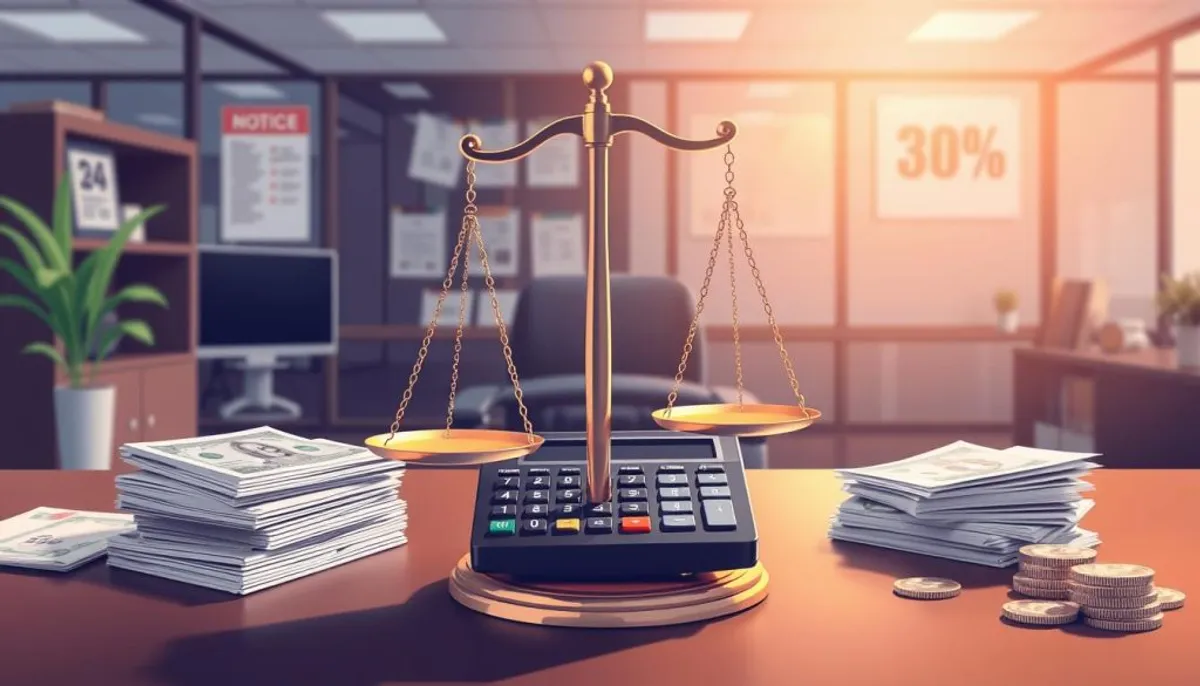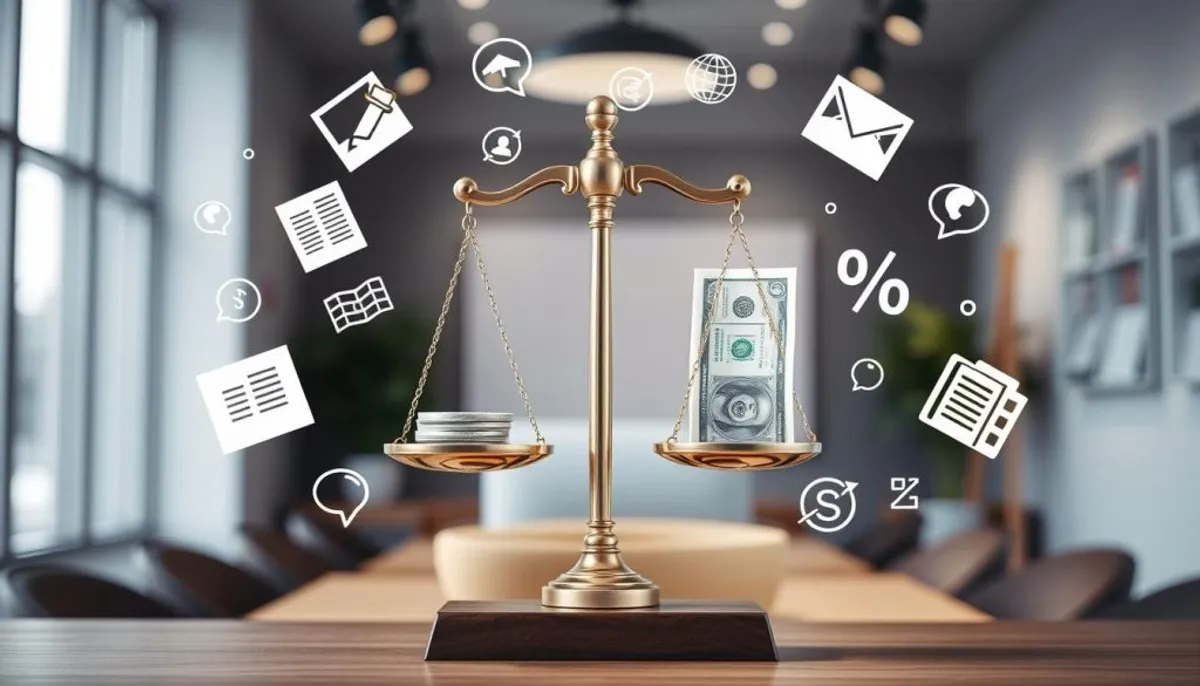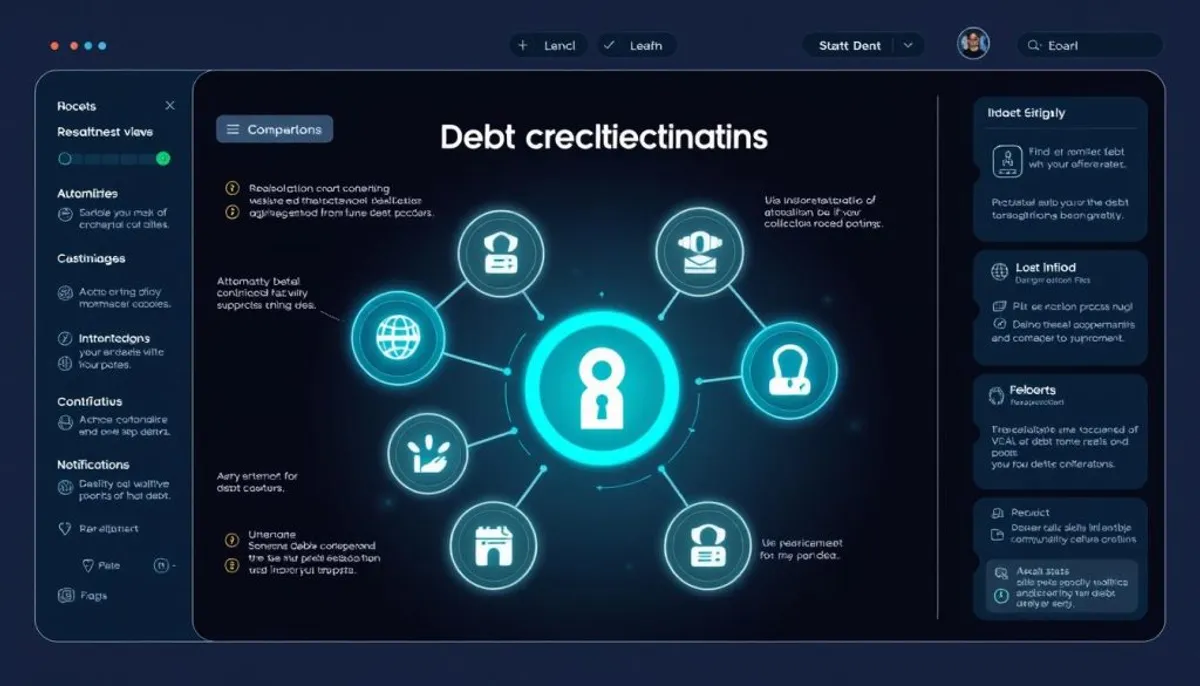Debt collection agency fees exhibit a broad spectrum, prompting numerous enterprises to scrutinize the true expense of retrieving unpaid debts. The rates for collection services span from 20% to 50% of the amount recovered, influenced by various elements. Grasping these charges is imperative for strategic decision-making in managing accounts receivable.

Primarily, agencies operate on a contingency basis, where they are remunerated only upon successful collection. This structure aligns their objectives with yours, fostering a diligent pursuit of your business’s interests. Certain entities, such as IC System, present flat fee alternatives, with charges ranging from $9 to $14.50 per account, contingent upon volume.
The age and magnitude of the debt are pivotal in determining the fees. Debts of advanced age are more challenging to collect, often leading to elevated rates. In contrast, substantial debts might attract lower percentage-based fees but could incur higher total expenditures. It is noteworthy that the efficacy of debt collection diminishes by over 1% each week, underscoring the urgency of immediate action.
Key Takeaways
- Debt collection fees typically range from 20% to 50% of recovered amounts
- Agencies often work on a contingency basis, only charging for successful collections
- Flat fee options exist, with some agencies charging per account
- Debt age and size significantly impact collection fees
- Success rates decline by over 1% weekly, highlighting the need for prompt action
- Additional services like credit reporting may incur extra charges
Understanding Debt Collection Agency Fee Structures
Exploring debt recovery costs necessitates an understanding of the fee structures employed by collection agencies. These structures significantly influence the costs associated with outstanding debt recovery and overall debt pursuit expenses.
Contingency-Based Collection Fees
Contingency fees represent the prevalent pricing model in debt collection. Agencies only receive compensation upon successful recovery of funds. The fee rates span from 20% to 50% of the collected sum.
The Kaplan Group implements a tiered contingency fee structure, contingent upon claim size:
| Claim Size | Fee Rate |
|---|---|
| $1,000 and under | 50% |
| $1,000 – $5,000 | 25% |
| $5,000 – $50,000 | 20% |
| $50,000 – $500,000 | 15% |
| Over $500,000 | 10% |
Flat Fee Collection Services
Flat fee services are offered by some agencies, where a fixed amount is charged per account, irrespective of collection success. These fees vary from $9 to $14.50 per account. This model is advantageous for businesses with numerous small debts, as it offers a predictable cost structure.
Hybrid Payment Models
Hybrid models integrate elements of contingency and flat fee structures. For instance, an agency might demand a small upfront fee alongside a lower percentage of recovered funds. This hybrid approach mitigates risk for both the agency and client, potentially reducing overall debt pursuit expenses.
How Much Does a Debt Collection Agency Charge: A Complete Breakdown
Debt collection agencies are vital in retrieving unpaid bills, yet their services incur costs. The fees for delinquent account collection vary, typically between 25% to 50% of the total debt. It is crucial for businesses to grasp these charges when contemplating professional collection services.
The magnitude of the debt profoundly influences the rates for unpaid bill collection. Smaller debts often attract higher percentage fees, whereas larger amounts may see lower rates. For example, debts under $1,000 might incur fees up to 50%, whereas those exceeding $500,000 could have rates as low as 10%.
| Debt Amount | Typical Fee Range |
|---|---|
| Under $1,000 | 40-50% |
| $1,000 – $5,000 | 30-40% |
| $5,000 – $100,000 | 20-30% |
| $100,000 – $500,000 | 15-20% |
| Over $500,000 | 10-15% |
Some agencies provide flat-fee services, beginning at $15 per account. This can be economical for businesses with numerous small debts. Extra services, such as credit reporting or skiptracing, may add to the overall expense of debt recovery.
When assessing collection agency fees, it is important to consider their success rates. A higher fee might be justified if the agency has a proven track record of recovering more debts. The true cost of debt collection hinges on the agency’s effectiveness and the specific characteristics of your unpaid accounts.
Factors Affecting Collection Agency Rates
Several elements influence the costs associated with overdue payment collection. Understanding these factors is crucial for businesses to strategize effectively in debt recovery.
Debt Age Impact on Fees
The age of a debt significantly impacts collection fees. Newer debts typically incur lower charges, whereas older debts are subject to higher rates due to reduced collectibility. For example, debts under 120 days old might incur a 20% fee. In contrast, debts over two years old could face a 50% fee.
Debt Size Considerations
The size of the debt also influences collection rates. Larger debts often have lower percentage fees, as agencies can recover more substantial amounts. This pricing structure allows for more flexibility in negotiating fees for businesses with diverse debt portfolios.

Industry-Specific Rate Variables
Different industries face varying collection rates. B2B debts may have distinct fee structures compared to consumer debts. Additional factors such as previous collection attempts, court judgments, or returned mail can also affect the cost of debt recovery services.
| Debt Age | Typical Charge |
|---|---|
| Less than 120 days | 20% |
| 120-180 days | 25% |
| 1-2 years | 40% |
| Over 2 years | 50% |
By considering these factors, businesses can anticipate and manage their overdue payment collection costs more effectively. This ensures a more efficient debt recovery process.
Contingency Fee Percentages and Tiers
Collection agency rates often follow a tiered structure based on debt size or age. This approach allows for flexibility in debt collection agency fees, adapting to the complexity of each case.
For smaller debts under $1,000, agencies might charge up to 50% of the recovered amount. As the debt size increases, the percentage typically decreases. For instance, debts between $1,000 and $5,000 might incur a 25% fee, while those over $50,000 could see rates as low as 10-15%.
Some agencies base their tiers on debt age instead. Fresh debts under 90 days old might have a 20% fee, while older debts of 1-2 years could reach 40%. This reflects the increasing difficulty of collection as time passes.
| Debt Amount | Typical Fee Percentage |
|---|---|
| Up to $500 | 25% |
| $500-$1,000 | 20% |
| $1,000-$5,000 | 12.5% |
| $5,000-$20,000 | 7.5% |
| Over $20,000 | 5% |
It’s crucial to understand these fee structures when choosing a collection agency. Remember, the goal is to maximize your debt recovery while keeping collection costs manageable.
Understanding Success Rates vs. Fee Structures
When assessing debt collection agencies, it’s vital to consider more than just the costs. The success rate of an agency is a critical factor in determining its true value. Let’s explore how success rates and fee structures interact within the debt collection process.
Industry Average Success Rates
Success rates in debt collection vary significantly across the industry. Agencies typically recover between 20% to 50% of outstanding debts. Yet, these figures can change based on factors like debt age and industry specifics. For example, success rates for debts two years old plummet to around 10%.
Cost-Effectiveness Analysis
When comparing debt collector charges, it’s crucial to evaluate cost-effectiveness. An agency with a higher fee percentage might be more cost-effective if they have a significantly higher success rate. For instance, an agency charging 20% with an 85% success rate could be more valuable than one charging 18% with only a 50% success rate.
ROI Considerations
Return on investment (ROI) in debt collection goes beyond fees—it’s about results. A higher upfront cost can lead to better returns if the agency has a proven track record of successful recoveries. When calculating ROI, consider both the agency’s fees and their historical success rates. This approach ensures you’re making an informed decision that balances debt recovery costs with actual results.
Alternative to Traditional Collection Agencies: ti3 Platform Solution
The ti3 platform introduces a novel method for managing overdue payments. It addresses the prevalent issues of debt pursuit expenses and overdue payment collection costs. Given that 89% of small-to-medium businesses face growth hindrances due to late payments, ti3 emerges as a crucial alternative.
Automated Payment Reminders
ti3 automates the debt collection process with weekly reminders sent via SMS and email. This persistent approach encourages debtors to settle their outstanding accounts. The platform’s efficiency is demonstrated by the fact that 30% of outstanding invoices typically require three or more reminders for resolution.
Streamlined Collection Process
The platform simplifies debt collection by offering instant discounts and flexible payment plans. Debtors can even share settlement links with friends and family for collective payments. This strategy is effective, as 50% of small businesses resort to personal finances due to late payments.

Cost-Saving Benefits
ti3’s cost-effective model is a standout in an industry where businesses spend about £5,000 annually on debt recovery. Creditors can select from various plans, including a $49 monthly subscription that reduces per-invoice costs to just 49 cents. This pricing structure offers substantial savings compared to traditional collection methods.
| Feature | ti3 Platform | Traditional Collection Agencies |
|---|---|---|
| Cost Structure | 49c – 99c per invoice | Typically 25-50% of collected amount |
| Payment Processing | Integrated (Stripe & PayPal) | Often separate |
| Debtor Interaction | Automated reminders | Manual calls and letters |
| Data Security | Encrypted data, audit trails | Varies by agency |
Additional Services and Their Costs
Debt collection agencies extend beyond basic recovery services. They offer additional options to enhance your chances of recovering outstanding debt. Understanding these add-ons is crucial, as they can significantly influence your overall costs.
Credit reporting is a prevalent extra service. It involves reporting unpaid debts to credit bureaus, aiming to prompt debtors to settle. Some agencies include this in their base fee, while others charge extra. Skiptracing, another valuable service, aids in locating debtors who have moved or changed their contact information.
Legal handling is a premium service offered by some agencies. It encompasses managing the legal process for debts requiring court action. This service, though more expensive, is beneficial for large or complex debts.
| Service | Average Cost |
|---|---|
| Credit Reporting | $10-$50 per account |
| Skiptracing | $25-$100 per search |
| Legal Handling | 15-30% of recovered amount |
Costs vary based on several factors, including debt age and size. For instance, a $1,000 debt might incur a 50% fee, whereas a $50,000 debt could be as low as 15%. It’s essential to understand what’s included in the base fee and what’s extra before signing a contract. This clarity ensures you can accurately estimate your total costs and make an informed decision.
The True Cost of Delayed Collections
Delaying collection efforts can severely impact your business’s financial health. The longer you wait to address unpaid bills, the more challenging it becomes to recover the owed money. Let’s examine the real costs of postponing collection activities.
Weekly Success Rate Decline
Collection success rates plummet as time elapses. Each week, the likelihood of collecting on a delinquent account drops by over 1%. After six months, the success rate plummets to 50%. Wait two years, and the chance of recovering funds dwindles to a mere 10%.
Financial Impact of Waiting
The financial repercussions of delayed collections are significant. Unpaid bill collection rates skyrocket as invoices age. For instance, collecting $1000 on an invoice aged 61-90 days costs between $7 and $9. This represents a staggering increase of almost 200% compared to invoices aged 31-60 days.
To illustrate this, consider these facts:
- The average cost of collecting $1000 is 69 cents when done promptly.
- Collection costs can be 400% to 900% higher for overdue invoices compared to those within the credit period.
- Debt collection agencies typically charge 20% to 50% of the invoice value as a success fee.
These statistics highlight the critical need for timely action on unpaid accounts. By addressing delinquent accounts promptly, businesses can avoid escalating collection costs and maintain healthier cash flow.
Choosing the Right Collection Service for Your Business
Choosing the right collection service is more than just comparing fees. It involves a detailed evaluation of several factors to ensure the best value for your investment. Let’s dive into the key considerations for making an informed decision.
Begin by assessing the agency’s success rate. Agencies like Summit Account Resolution achieve a 34.8% recovery rate, with some cases reaching 80%. Rocket Receivable boasts a recovery rate four times the industry average. Such figures can greatly influence your financial outcomes.
Next, consider the agency’s specialization in your industry. B2B claims often require specific expertise. Opt for agencies with experience in your sector to enhance results. For example, Prestige Services Inc. (PSI) offers volume discounts and maintains a solid 38% recovery rate.
Examine the fee structure with care. While contingency-based rates range from 7% to 50%, lower fees don’t always translate to higher returns. An agency with higher charges but better recovery rates can yield greater financial gains.
- Check for additional services offered
- Assess the agency’s approach to maintaining client relationships
- Verify their ability to handle claims of various sizes and ages
- Ensure they’re licensed in areas where your customers reside
Lastly, consider the agency’s technological capabilities. Agencies with online portals for real-time updates and efficient communication can streamline your collection process. By considering these factors, you can find a collection service that meets your business needs and maximizes your recovery potential.
Conclusion
Grasping the cost of debt collection agencies is vital for companies aiming to reclaim unpaid debts. Fees for such services vary, often between 25% to 50% of the recovered amount. This range is influenced by several elements, including the debt’s age, size, and the industry it belongs to. The primary fee models include contingency fees, flat fees, and hybrid approaches.
Assessing the fees of debt collection agencies requires a look at their success rates and overall value. Agencies with superior success rates might charge more due to their higher recovery probabilities. For debts exceeding $5,000, contingency fees typically fall between 20-25%. In contrast, debts under $1,000 might incur fees ranging from 30-40%.
Platforms like ti3 offer economical ways to handle overdue payments. Regardless of the chosen strategy, acting swiftly is paramount. The likelihood of successful collection drops sharply with time, emphasizing the need for immediate action. By meticulously examining options and considering various aspects, businesses can pinpoint the most fitting debt collection strategy for their specific requirements.
RelatedRelated articles



